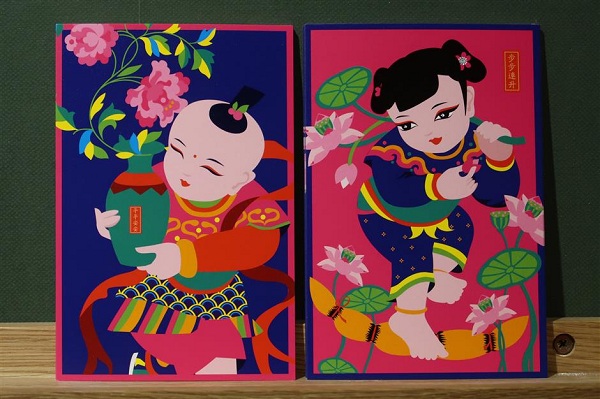
Traditional Spring Festival art is also on display at Yuyuan Garden. (Wang Rongjiang/SHINE)
"In terms of artistic style, Xiaojiaochang prints are much different from other woodblock art," Zhang says.
Traditional New Year pictures painted by farmers were done in bold, bright colors and rough lines, which always make the prints seem crowded. Xiaojiaochang art, on the other hand, was created by professional craftsmen. They feature light, elegant colors and smooth lines, with imaginative layouts for calligraphy and poems.
The Xiaojiaochang pictures discovered so far are all relatively small in size.
"That's because urban people lived in crowded apartments and had to share toilets and kitchens with neighbors," Zhang says. "They preferred smaller paintings that were easier to hang at home."
Unfortunately, the genre has been lost today. While woodblock art still flourishes in many rural areas, there are no known old craftsmen toiling away in some atelier, trying to preserve the tradition of Xiaojiaochang.
Because they are so rare — a number estimated to be no more than 1,000 — Xiaojiaochang prints have become prized collector's items. The remaining originals are scattered among museums, institutions and private collectors.
"As a historic researcher, I'm doing what I should do for the city," Zhang says of his work.
In 2011, he was chief editor of a chapter on Xiajiaochang New Year pictures in a book on Chinese woodblock print.
His research found precious records or documents about the art form.
"It seems this form of woodblock printing disappeared overnight," Zhang says.
He adds that prints claimed by collectors to be genuine often aren't the true Xiaojiaochang pictures.
"Many of them were machine-made after 1911, not handmade," Zhang says.
He thinks Xiaojiaochang prints died because of the speed of Shanghai's modernization.
"At the time Xiaojiaochang prints reached their peak, the city was about to embrace machine printing," he says.
Machine printing was more efficient and colorful than handmade woodblock printing. Machines could turn out more than 900 prints an hour, whereas the method used to make Xiaojiaochang prints was laborious and required meticulous skills.
Each color in a print needed a separately carved woodblock. Ten colors meant 10 blocks. Then, the separately colored parts had to be fitted together, one on top of another.
"The end of woodcut prints was kind of inevitable in the city's development," Zhang says. "We are trying to piece its past together and complete the history."
Xiaojiaochang New Year's pictures exhibition
Date: Through March 5
Venue: 2/F, Huabao Tower of Yuyuan Malls
Address: 265 Fangbang Rd M.
How to get there: Yuyuan Garden Station of Metro Line 10


















































